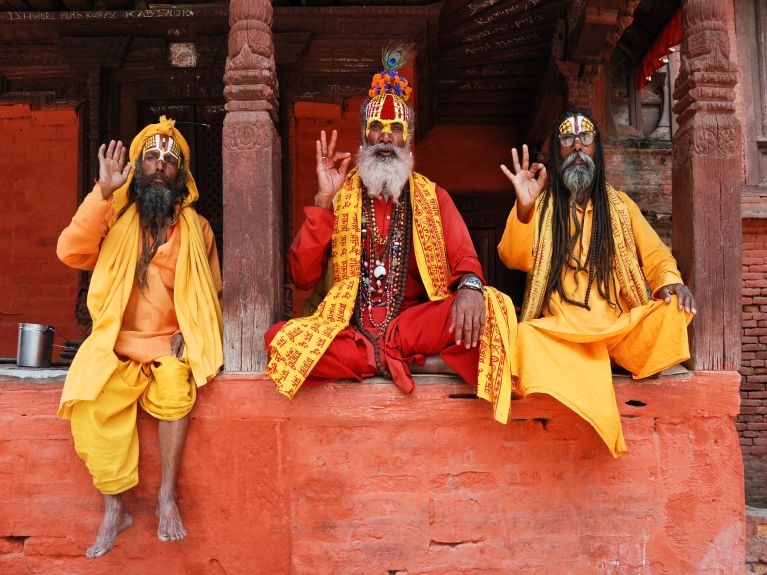
India’s Kumbh Mela on Thursday found a place in the United Nations Educational, Scientific and Cultural Organization’s list of “intangible heritage”, with the organisation saying that the festival is the “largest peaceful congregation of pilgrims on earth”.
The decision to include the festival in Unesco’s Representative List of Intangible Cultural Heritage of Humanity was taken at the ongoing meeting of the organisation’s World Heritage Committee in South Korea. The meeting, which opened on December 4, will end on December 9.
Unesco said Kumbh Mela plays a central role in India’s spirituality, “exerting a mesmeric influence” on the people of the country.
“Knowledge and skills related to the tradition are transmitted through ancient religious manuscripts, oral traditions, historical travelogues and texts produced by eminent historians,” Unesco said on its website. “However, the teacher-student relationship of the sadhus in the ashrams and akhadas remains the most important method of imparting and safeguarding knowledge and skills relating to Kumbh Mela.”
Kumbh Mela, considered the world’s largest congregation of religious pilgrims, joins contenders from Botswana, Colombia, Venezuela, Mongolia, Morocco, Turkey and the United Arab Emirates. “A very proud moment for us as sacred Kumbh Mela is just inscribed as the Intangible Cultural Heritage of Humanity by UNESCO,” Culture Minister Mahesh Sharma tweeted.
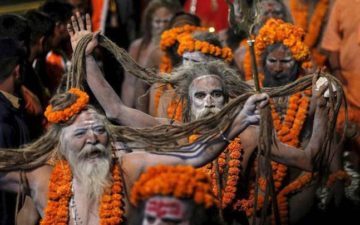
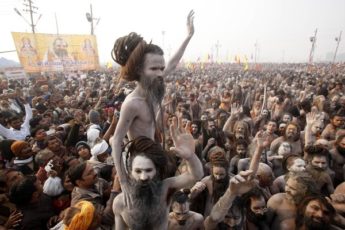
Kumbh Mela is a mass Hindu pilgrimage of faith in which Hindus gather to bathe in a sacred or holy river. Traditionally, four fairs are widely recognized as the Kumbh Melas: the Haridwar Kumbh Mela, the Allahabad Kumbh Mela, the Nashik–Trimbakeshwar Simhastha, and Ujjain Simhastha.
These four fairs are held periodically at one of the following places by rotation:
Haridwar, Allahabad(Prayaga), Nashik district (Nashik and Trimbak), and Ujjain. The main festival site is located on the banks of a river: the Ganges(Ganga) at Haridwar; the confluence (Sangam) of the Ganges and the Yamuna and the invisible Sarasvati at Allahabad; the Godavari at Nashik; and the Shipra at Ujjain. Bathing in these rivers is thought to cleanse a person of all sins.
At any given place, the Kumbh Mela is held once in 12 years.
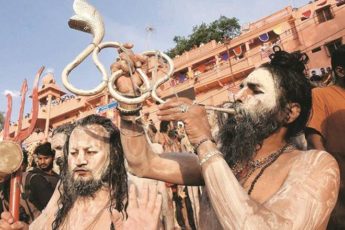
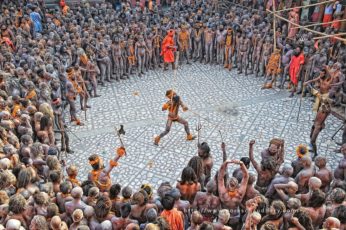 The exact age of the festival is uncertain. According to medieval Hindu mythology, Lord Vishnu dropped drops of Amrita (the drink of immortality) at four places, while transporting it in a kumbha (pot). These four places are identified as the present-day sites of the Kumbh Mela. The name “Kumbh Mela” literally means “kumbha fair”. It is known as “Kumbh” in Hindi (due to schwa deletion); in Sanskrit and some other Indian languages, it is more often known by its original name “Kumbha”
The exact age of the festival is uncertain. According to medieval Hindu mythology, Lord Vishnu dropped drops of Amrita (the drink of immortality) at four places, while transporting it in a kumbha (pot). These four places are identified as the present-day sites of the Kumbh Mela. The name “Kumbh Mela” literally means “kumbha fair”. It is known as “Kumbh” in Hindi (due to schwa deletion); in Sanskrit and some other Indian languages, it is more often known by its original name “Kumbha”
The festival is one of the largest peaceful gatherings in the world, and considered as the “world’s largest congregation of religious pilgrims”. There is no precise method of ascertaining the number of pilgrims, and the estimates of the number of pilgrims bathing on the most auspicious day may vary. An estimated 120 million people visited Maha Kumbh Mela in 2013 in Allahabad over a two-month period, including over 30 million on a single day, on 10 February 2013 (the day of Mauni Amavasya).
Mythological origin
According to medieval Hindu mythology, the origin of the festival can be found in the ancient legend of samudra manthan. The legend tells of a battle between the Devas and Asuras for amrita, the drink of immortality.
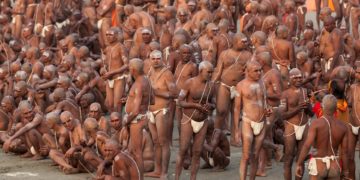
During samudra manthan, or churning of the ocean, amrita was produced and placed in a kumbha (pot). To prevent the asuras (malevolent beings) from seizing the amrita, a divine carrier flew away with the pot. In one version of the legend, the carrier of the kumbha is the divine physician Dhanavantari, who stops at four places where the Kumbh Mela is celebrated. In other re-tellings, the carrier is Garuda, Indra or Mohini, who spills the amrita at four places.
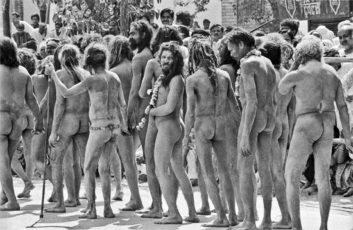
While several ancient texts, including the various Puranas, mention the samudra manthan legend, none of them mentions spilling of the amrita at four places. Neither do these texts mention the Kumbh Mela. Therefore, multiple scholars, including R. B. Bhattacharya, D. P. Dubey and Kama Maclean believe that the samudra manthan legend has been applied to the Kumbh Mela relatively recently, in order to show scriptural authority for it.
History
There are several references to river-side festivals in ancient Indian texts, but the exact age of the Kumbh Mela is uncertain. The Chinese traveler Xuanzang (Hiuen Tsang) describes a ritual organized by Emperor Shiladitya (identified with Harsha) at the confluence of two rivers, in the kingdom of Po-lo-ye-kia (identified with Prayaga). He also mentions that many hundreds took a bath at the confluence, to wash away their sins. According to some scholars, this is earliest surviving historical account of the Kumbh Mela, which took place in present-day Allahabad in 644 CE.
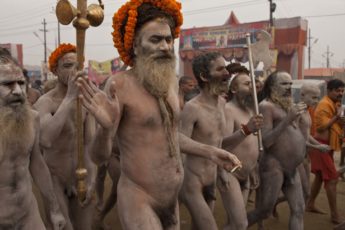
However, Australian researcher Kama Maclean notes that the Xuanzang reference is about an event that happened every 5 years (and not 12 years), and might have been a Buddhist celebration (since Harsha was a Buddhist emperor).
A common conception, advocated by the akharas, is that Adi Shankara started the Kumbh Mela at Prayag in 8th century, to facilitate meeting of holy men from different regions. However, academics doubt the authenticity of this claim.
The Kumbh Mela of Haridwar appears to be the original Kumbh Mela, since it is held according to the astrological sign “Kumbha” (Aquarius), and because there are several references to a 12-year cycle for it. The earliest extant texts that contain the name “Kumbha Mela” are Khulasat-ut-Tawarikh (1695 CE) and Chahar Gulshan (1759 CE). Both these texts use the term “Kumbh Mela” to describe only Haridwar’s fair, although they mention the similar fairs held in Allahabad and Nashik district.[18] The Khulasat-ut-Tawarikh lists the following melas: an annual mela and a Kumbh Mela every 12 years at Haridwar; a mela held at Trimbak when Jupiter enters Leo (that is, once in 12 years); and an annual mela held at Prayag in Magh. The Magh Mela of Allahabad is probably the oldest among these, dating from the early centuries CE, and has been mentioned in several Puranas. However, its association with the Kumbha myth and the 12-year old cycle is relatively recent, probably dating back to the mid-19th century. D. P. Dubey notes that none of the ancient Hindu texts mention the Allahabad fair as a “Kumbh Mela”. Kama Maclean states that even early British records do not mention the name “Kumbh Mela” or the 12-year cycle for the Allahabad’s fair. The first British reference to the Kumbh Mela in Allahabad occurs only in an 1868 report, which mentions the need for increased pilgrimage and sanitation controls at the “Coomb fair” to be held in January 1870.
According to Maclean, the Prayagwal Brahmin priests of Allahabad adapted their annual Magh Mela to Kumbh legend, in order to increase the importance of their tirtha.
The Kumbh Mela at Ujjain began in the 18th century, when the Maratha ruler Ranoji Shinde invited ascetics from Nashik to Ujjain for a local festival. Like the priests at Allahabad, the pandits of Nashik and Ujjain, competing with other places for a sacred status, may have adopted the Kumbh tradition for their pre-existing melas.
Until the East India Company rule, the Kumbh Melas were managed by the akharas (sects) of religious ascetics known as the sadhus. They collected taxes, and also carried out policing and judicial duties. The sadhus were heavily militarized, and also participated in trade. The Melas were a scene of sectarian politics, which sometimes turned violent. The Chahar Gulshan states that the local sanyasis at Haridwar attacked the fakirs of Prayag who came to attend the Kumbh Mela there.
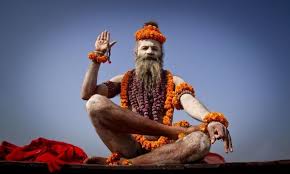
At the 1760 Kumbh Mela in Haridwar, a clash broke out between Shaivite Gosains and Vaishnavite Bairagis (ascetics), resulting in hundreds of deaths, with Vaishnavite forming most of the victims.
A copper plate inscription of the Maratha Peshwa claims that 12,000 ascetics died in a clash between Shaivite sanyasis and Vaishnavite bairagis at the 1789 Nashik Kumbh Mela. The dispute started over the bathing order, which indicated status of the akharas. At the 1796 Kumbh Mela in Haridwar, the Shaivites attacked and injured the Udasis for erecting a camp without their permission. In response, the Khalsa Sikhs accompanying the Udasis killed around 500 Gosains; the Sikhs lost around 20 men in the clash. The clashes subsided after the Company administration severely limited the trader-warrior role of the sadhus, who were increasingly reduced to begging.
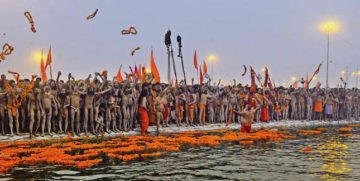
Besides their religious significance, historically the Kumbh Melas were also major commercial events. Baptist missionary John Chamberlain, who visited the 1824 Ardh Kumbh Mela at Haridwar, stated that a large number of visitors came there for trade. He noted that the fair was attended by “multitudes of every religious order”, including a large number of Sikhs. According to an 1858 account of the Haridwar Kumbh Mela by the British civil servant Robert Montgomery Martin, the visitors at the fair included people from a number of races and religions. Besides priests, soldiers, and religious mendicants, the fair was attended by several merchants, including horse traders from Bukhara, Kabul, Turkistan, Arabia and Persia. Several Hindu rajas, Sikh rulers and Muslim Nawabs visited the fair. A few Christian missionaries also preached at the Mela.
The Kumbh Melas played an important role in spread of the cholera outbreaks and pandemics. The British administrators made several attempts to improve the sanitary conditions at the Melas, but thousands of people died of cholera at these fairs until the mid-20th century.
Several stampedes have occurred at the Kumbh Melas. After an 1820 stampede at Haridwar that killed 430 people, the Company government took extensive infrastructure projects, including construction of new ghats and road widening, to prevent further stampedes. Since then Haridwar has experienced fewer deaths in stampedes: the next big stampede occurred in 1986, when 50 people were killed. Allahabad has also experienced major stampedes, in 1840, 1906, 1954, 1986 and 2013. The deadliest of these was the 1954 stampede, which left 800 people dead.
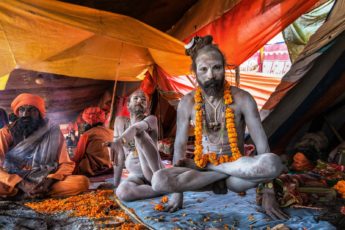
Dates
The Kumbh Mela occurrences follow the Hindu calendar, as follows:
- The Kumbh Mela (sometimes specifically called Purna Kumbhor “full Kumbha”), occurs every 12 years at a given site.
- Ardh Kumbh (“Half Kumbh”) Mela occurs between the two Purna Kumbha Melas at Prayag and Haridwar.
- The Maha Kumbh occurs after 12 Purna Kumbh Melas i.e. every 144 years.
The Kumbh Mela at Prayag is celebrated after approximately 3 years of Kumbh Mela at Haridwar. There is a difference of around 3 years between the Kumbh Festivals at Prayag and Nashik. Kumbh at Nashik and Ujjain are celebrated in the same year or one year apart.
Attendance
In 2001, more than 40 million gathered on the busiest of its 55 days.
According to the Mela Administration’s estimates, around 70 million people participated in the 45-day Ardha Kumbh Mela at Prayag in 2007.
The 2001 Kumbh Mela at Allahabad (Prayag) was estimated by the authorities to have attracted between 30 and 70 million people. The estimated attendance for the 2013 Allahabad Kumbh Mela was 120 million.
The Ritual
One of the major events of Kumbh Mela is the Peshwai Procession, which marks the arrival of the members of an akhara or sect of sadhus at the Kumbh Mela.
The major event of the festival is ritual bathing at the banks of the river in whichever town Kumbh Mela being held:Ganga in Haridwar, Godavari in Nasik, Kshipra in Ujjain and Sangam (confluence of Ganga, Yamuna and mythical Saraswati) in Allahabad (Prayag). Nasik has registered maximum visitors to 75 million. Other activities include religious discussions, devotional singing, mass feeding of holy men and women and the poor, and religious assemblies where doctrines are debated and standardised. Kumbh Mela is the most sacred of all the pilgrimages. Thousands of holy men and women attend, and the auspiciousness of the festival is in part attributable to this. The sadhus are seen clad in saffron sheets with Vibhuti ashes dabbed on their skin as per the requirements of ancient traditions. Some, called naga sanyasis, may not wear any clothes even in severe winter. The right to be naga, or naked, is considered a sign of separation from the material world.
After visiting the Kumbh Mela of 1895, Mark Twain wrote:
“It is wonderful, the power of a faith like that, that can make multitudes upon multitudes of the old and weak and the young and frail enter without hesitation or complaint upon such incredible journeys and endure the resultant miseries without repining. It is done in love, or it is done in fear; I do not know which it is. No matter what the impulse is, the act born of it is beyond imagination, marvelous to our kind of people, the cold whites.”
Darshan
The order of entering the water is fixed, with the Juna, the Niranjani and Mahanirvani akharas preceding.
Darshan, or respectful visual exchange, is an important part of the Kumbh Mela. People make the pilgrimage to the Kumbh Mela specifically to observe and experience both the religious and secular aspects of the event. Two major groups that participate in the Kumbh Mela include the Sadhus (Hindu holy men) and pilgrims. Through their continual yogic practices the Sadhus articulate the transitory aspect of life. Sadhus travel to the Kumbh Mela to make themselves available to much of the Hindu public. This allows members of the Hindu public to interact with the Sadhus and to take “darshan.” They are able to “seek instruction or advice in their spiritual lives.” Darshan focuses on the visual exchange, where there is interaction with a religious deity and the worshiper is able to visually “‘drink’ divine power.” The Kumbh Mela is arranged in camps that give Hindu worshipers access to the Sadhus. The darshan is important to the experience of the Kumbh Mela and because of this worshipers must be careful so as to not displease religious deities. Seeing of the Sandus is carefully managed and worshipers often leave tokens at their feet.
Kumbh Mela has received extensive media coverage, with several documentaries and films based on it.
Kumbh Mela has been theme for many a documentaries, including Kings with Straw Mats (1998) directed by Ira Cohen, Kumbh Mela: The Greatest Show on Earth (2001) directed by Graham Day, Short Cut to Nirvana: Kumbh Mela (2004) directed by Nick Day and produced by “Maurizio Benazzo”, Kumbh Mela: Songs of the River (2004) by Nadeem Uddin, Invocation, Kumbh Mela (2008), Kumbh Mela: Walking with the Nagas (2011), Amrit: Nectar of Immortality (2012) directed by Jonas Scheu and Philipp Eyer, Inside the Mahakumbh (2013) by the National Geographic Channel and Kumbh Mela 2013: living with Mahatiagi (2013) by the Ukrainian Religious Studies Project Ahamot.
Indian and foreign news media have covered the Kumbh Mela regularly. On 18 April 2010, a popular American morning show CBS News Sunday Morning extensively covered Haridwar’s Kumbh Mela, calling it “The Largest Pilgrimage on Earth“. On 28 April 2010, BBC reported an audio and a video report on Kumbh Mela, titled “Kumbh Mela ‘greatest show on earth.”
